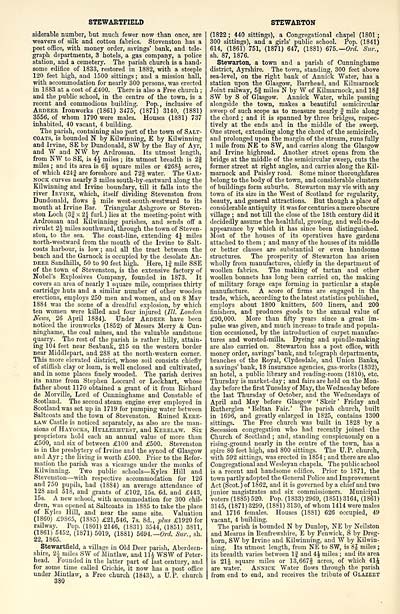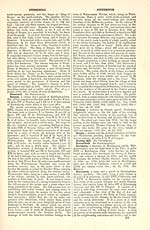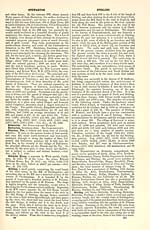Ordnance gazetteer of Scotland > Volume 6
(198) Page 380 - STE
Download files
Complete book:
Individual page:
Thumbnail gallery: Grid view | List view

STEWARTFIELD
siderable number, but mucb fewer now than once, are
weavers of silk and cotton fabrics. Stevenston has a
post office, with money order, savings' bank, and tele-
graph departments, 3 hotels, a gas company, a police
station, and a cemetery. The parish church is a hand-
some edifice of 1833, restored in 1882, with a steeple
120 feet high, and 1500 sittings ; and a mission hall,
with accommodation for nearly 300 persons, was erected
in 1883 at a cost of £400. There is also a Free church ;
and the public school, in the centre of the town, is a
recent and commodious building. Pop., inclusive of
Ardeer Ironworks (1861) 3475, (1871) 3140, (1881)
3556, of whom 1790 were males. Houses (1881) 737
inhabited, 40 vacant, 4 building.
The parish, containing also part of the town of Salt-
coats, is bounded N by Kilwinning, E by Kilwinning
and Irvine, SE by Dundonald, SW by the Bay of Ayr,
and W and NW by Ardrossan. Its utmost length,
from NW to SE, is 4$ miles ; its utmost breadth is 2|
miles ; and its area is 6| square miles or 4268$ acres,
of which 424| are foreshore and 72| water. The Gar-
nock curves nearly 3 miles south-by-eastward along the
Kilwinning and Irvine boundary, till it falls into the
river Irvine, which, itself dividing Stevenston from
Dundonald, flows $ mile west-south-westward to its
mouth at Irvine Bar. Triangular Ashgrove or Steven-
ston Loch (3| x 2£ furl.) lies at the meeting-point with
Ardrossan and Kilwinning parishes, and sends off a
rivulet 2J miles southward, through the town of Steven-
ston, to the sea. The coast-line, extending 4J miles
north-westward from the mouth of the Irvine to Salt-
coats harbour, is low ; and all the tract between the
beach and the Garnock is occupied by the desolate Ar-
deer Sandhills, 50 to 90 feet high. Here, If mile SSE
of the town of Stevenston, is the extensive factory of
Nobel's Explosives Company, founded in 1873. It
covers an area of nearly 1 square mile, comprises thirty
cartridge huts and a similar number of other wooden
erections, employs 250 men and women, and on 8 May
1884 was the scene of a dreadful explosion, by which
ten women were killed and four injured (HI. London
News, 26 April 1884). Under Ardeer have been
noticed the ironworks (1852) of Messrs Merry & Cun-
ninghame, the coal mines, and the valuable sandstone
quarry. The rest of the parish is rather hilly, attain-
ing 104 feet near Seabank, 215 on the western border
near Middlepart, and 288 at the north-western corner.
This more elevated district, whose soil consists chiefly
of stiffish clay or loam, is well enclosed and cultivated,
and in some places finely wooded. The parish derives
its name from Stephen Loccard or Lockhart, whose
father about 1170 obtained a grant of it from Richard
de Morville, Lord of Cunninghame and Constable of
Scotland. The second steam engine ever employed in
Scotland was set up in 1719 for pumping water between
Saltcoats and the town of Stevenston. Kuined Kere-
law Castle is noticed separately, as also are the man-
sions of Hayocks, Hullerhurst, and Kerelaw. Six
proprietors hold each an annual value of more than
£500, and six of between £100 and £500. Stevenston
is in the presbytery of Irvine and the synod of Glasgow
and Ayr ; the living is worth £500. Prior to the Refor-
mation the parish was a vicarage under the monks of
Kilwinning. Two public schools— Kyles Hill and
Stevenston — with respective accommodation for 126
and 750 pupils, had (1S84) an average attendance of
128 and 51S, and grants of £102, 15s. 6d. and £443,
15s. A new school, with accommodation for 300 chil-
dren, was opened at Saltcoats in 1885 to take the place
of Kyles Hill, and near the same site. Valuation
(1860) £9865, (1885) £21,546, 7s. 8d., plus £1920 for
railway. Pop. (1801)2146, (1831) 3544, (1851) 3811,
(1861) 5452, (1871) 5019, (1881) 5694.— Ord. Sur., sh.
22, 1865.
Stewartfield, a village in Old Deer parish, Aberdeen-
shire, 2J miles SW of Mintlaw, and 11$ WSW of Peter-
head. Founded in the latter part of last century, and
for some time called Crichie, it now has a post office
under Mintlaw, a Free church (1843), a U.P. church
330
STEWARTON
(1822 ; 440 sittings), a Congregational chapel (1801 ;
300 sittings), and a girls' public school. Pop. (1841)
614, (1861) 751, (1871) 647, (1881) 675.— Ord. Sur.,
sh. 87, 1876.
Stewarton, a town and a parish of Cunninghame
district, Ayrshire. The town, standing, 300 feet above
sea-level, on the right bank of Annick Water, has a
station upon the Glasgow, Barrhead, and Kilmarnock
Joint railway, 5| miles N by W of Kilmarnock, and 18|
SW by S of Glasgow. Annick Water, while passing
alongside the town, makes a beautiful semicircular
sweep of such scope as to measure nearly J mile along
the chord ; and it is spanned by three bridges, respec-
tively at the ends and in the middle of the sweep.
One street, extending along the chord of the semicircle,
and prolonged upon the margin of the stream, runs fully
1 mile from NE to SW, and carries along the Glasgow
and Irvine highroad. Another street opens from the
bridge at the middle of the semicircular sweep, cuts the
former street at right angles, and carries along the Kil-
marnock and Paisley road. Some minor thoroughfares
belong to the body of the town, and considerable clusters
of buildings form suburbs. Stewarton may vie with any
town of its size in the West of Scotland for regularity,
beauty, and general attractions. But though a place of
considerable antiquity it was for centuries a mere obscure
village ; and not till the close of the 18th century did it
decidedly assume the healthful, growing, and well-to-do
appearance by which it has since been distinguished.
Most of the houses of its operatives have gardens
attached to them ; and many of the houses of its middle
or better classes are substantial or even handsome
structures. The prosperity of Stewarton has arisen
wholly from manufactures, chiefly in the department of
woollen fabrics. The making of tartan and other
woollen bonnets has long been carried on, the making
of military forage caps forming in particular a staple
manufacture. A score of firms are engaged in the
trade, which, according to tho latest statistics published,
employs about 1800 knitters, 500 liners, and 200
finishers, and produces goods to the annual value of
£90,000. More than fifty years since a great im-
pulse was given, and much increase to trade and popula-
tion occasioned, by the introduction of carpet manufac-
tures and worsted-mills. Dyeing and spindle-making
are also carried on. Stewarton has a post office, with
money order, savings' bank, and telegraph departments,
branches of the Royal, Clydesdale, and Union Banks,
a savings' bank, 18 insurance agencies, gas-works (1832),
an hotel, a public library and reading-room (1810), etc.
Thursday is market-day ; and fairs are held on the Mon-
day before the first Tuesday of May, the Wednesday before
the last Thursday of October, and the Wednesdays of
April and May before Glasgow ' Skeir ' Friday and
Rutherglen ' Beltan Fair. ' The parish church, built
in 1696, and greatly enlarged in 1825, contains 1300
sittings. The Free church was built in 1828 by a
Secession congregation who had recently joined the
Church of Scotland ; and, standing conspicuously on a
rising-ground nearly in the centre of the town, has a
spire 80 feet high, and 800 sittings. The U. P. church,
with 592 sittings, was erected in 1854 ; and there are also
Congregational and Wesleyan chapels. The public school
is a recent and handsome edifice. Prior to 1871, the
town partly adopted the General Police and Improvement
Act (Scot.) of 1862, and it is governed by a chief and two
junior magistrates and six commissioners. Municipal
voters (1885) 520. Pop. (1833) 2969, (1851) 3164, (1861)
3145, (1871) 3299, (1881) 3130, of whom 1414 were males
and 1716 females. Houses (1881) 626 occupied, 49
vacant, 4 building.
The parish is bounded N by Dunlop, NE by Neilston
and Mearns in Renfrewshire, E by Fenwick, S by Dreg-
horn, SW by Irvine and Kilwinning, and W by Kilwin-
ning. Its utmost length, from NE to SW, is 8J miles ;
its breadth varies between If and 4J miles ; and its area
is 21J square miles or 13,667§ acres, of which 41$
are water. Annick Water flows through the parish
from end to end, and receives the tribute of Glazert
siderable number, but mucb fewer now than once, are
weavers of silk and cotton fabrics. Stevenston has a
post office, with money order, savings' bank, and tele-
graph departments, 3 hotels, a gas company, a police
station, and a cemetery. The parish church is a hand-
some edifice of 1833, restored in 1882, with a steeple
120 feet high, and 1500 sittings ; and a mission hall,
with accommodation for nearly 300 persons, was erected
in 1883 at a cost of £400. There is also a Free church ;
and the public school, in the centre of the town, is a
recent and commodious building. Pop., inclusive of
Ardeer Ironworks (1861) 3475, (1871) 3140, (1881)
3556, of whom 1790 were males. Houses (1881) 737
inhabited, 40 vacant, 4 building.
The parish, containing also part of the town of Salt-
coats, is bounded N by Kilwinning, E by Kilwinning
and Irvine, SE by Dundonald, SW by the Bay of Ayr,
and W and NW by Ardrossan. Its utmost length,
from NW to SE, is 4$ miles ; its utmost breadth is 2|
miles ; and its area is 6| square miles or 4268$ acres,
of which 424| are foreshore and 72| water. The Gar-
nock curves nearly 3 miles south-by-eastward along the
Kilwinning and Irvine boundary, till it falls into the
river Irvine, which, itself dividing Stevenston from
Dundonald, flows $ mile west-south-westward to its
mouth at Irvine Bar. Triangular Ashgrove or Steven-
ston Loch (3| x 2£ furl.) lies at the meeting-point with
Ardrossan and Kilwinning parishes, and sends off a
rivulet 2J miles southward, through the town of Steven-
ston, to the sea. The coast-line, extending 4J miles
north-westward from the mouth of the Irvine to Salt-
coats harbour, is low ; and all the tract between the
beach and the Garnock is occupied by the desolate Ar-
deer Sandhills, 50 to 90 feet high. Here, If mile SSE
of the town of Stevenston, is the extensive factory of
Nobel's Explosives Company, founded in 1873. It
covers an area of nearly 1 square mile, comprises thirty
cartridge huts and a similar number of other wooden
erections, employs 250 men and women, and on 8 May
1884 was the scene of a dreadful explosion, by which
ten women were killed and four injured (HI. London
News, 26 April 1884). Under Ardeer have been
noticed the ironworks (1852) of Messrs Merry & Cun-
ninghame, the coal mines, and the valuable sandstone
quarry. The rest of the parish is rather hilly, attain-
ing 104 feet near Seabank, 215 on the western border
near Middlepart, and 288 at the north-western corner.
This more elevated district, whose soil consists chiefly
of stiffish clay or loam, is well enclosed and cultivated,
and in some places finely wooded. The parish derives
its name from Stephen Loccard or Lockhart, whose
father about 1170 obtained a grant of it from Richard
de Morville, Lord of Cunninghame and Constable of
Scotland. The second steam engine ever employed in
Scotland was set up in 1719 for pumping water between
Saltcoats and the town of Stevenston. Kuined Kere-
law Castle is noticed separately, as also are the man-
sions of Hayocks, Hullerhurst, and Kerelaw. Six
proprietors hold each an annual value of more than
£500, and six of between £100 and £500. Stevenston
is in the presbytery of Irvine and the synod of Glasgow
and Ayr ; the living is worth £500. Prior to the Refor-
mation the parish was a vicarage under the monks of
Kilwinning. Two public schools— Kyles Hill and
Stevenston — with respective accommodation for 126
and 750 pupils, had (1S84) an average attendance of
128 and 51S, and grants of £102, 15s. 6d. and £443,
15s. A new school, with accommodation for 300 chil-
dren, was opened at Saltcoats in 1885 to take the place
of Kyles Hill, and near the same site. Valuation
(1860) £9865, (1885) £21,546, 7s. 8d., plus £1920 for
railway. Pop. (1801)2146, (1831) 3544, (1851) 3811,
(1861) 5452, (1871) 5019, (1881) 5694.— Ord. Sur., sh.
22, 1865.
Stewartfield, a village in Old Deer parish, Aberdeen-
shire, 2J miles SW of Mintlaw, and 11$ WSW of Peter-
head. Founded in the latter part of last century, and
for some time called Crichie, it now has a post office
under Mintlaw, a Free church (1843), a U.P. church
330
STEWARTON
(1822 ; 440 sittings), a Congregational chapel (1801 ;
300 sittings), and a girls' public school. Pop. (1841)
614, (1861) 751, (1871) 647, (1881) 675.— Ord. Sur.,
sh. 87, 1876.
Stewarton, a town and a parish of Cunninghame
district, Ayrshire. The town, standing, 300 feet above
sea-level, on the right bank of Annick Water, has a
station upon the Glasgow, Barrhead, and Kilmarnock
Joint railway, 5| miles N by W of Kilmarnock, and 18|
SW by S of Glasgow. Annick Water, while passing
alongside the town, makes a beautiful semicircular
sweep of such scope as to measure nearly J mile along
the chord ; and it is spanned by three bridges, respec-
tively at the ends and in the middle of the sweep.
One street, extending along the chord of the semicircle,
and prolonged upon the margin of the stream, runs fully
1 mile from NE to SW, and carries along the Glasgow
and Irvine highroad. Another street opens from the
bridge at the middle of the semicircular sweep, cuts the
former street at right angles, and carries along the Kil-
marnock and Paisley road. Some minor thoroughfares
belong to the body of the town, and considerable clusters
of buildings form suburbs. Stewarton may vie with any
town of its size in the West of Scotland for regularity,
beauty, and general attractions. But though a place of
considerable antiquity it was for centuries a mere obscure
village ; and not till the close of the 18th century did it
decidedly assume the healthful, growing, and well-to-do
appearance by which it has since been distinguished.
Most of the houses of its operatives have gardens
attached to them ; and many of the houses of its middle
or better classes are substantial or even handsome
structures. The prosperity of Stewarton has arisen
wholly from manufactures, chiefly in the department of
woollen fabrics. The making of tartan and other
woollen bonnets has long been carried on, the making
of military forage caps forming in particular a staple
manufacture. A score of firms are engaged in the
trade, which, according to tho latest statistics published,
employs about 1800 knitters, 500 liners, and 200
finishers, and produces goods to the annual value of
£90,000. More than fifty years since a great im-
pulse was given, and much increase to trade and popula-
tion occasioned, by the introduction of carpet manufac-
tures and worsted-mills. Dyeing and spindle-making
are also carried on. Stewarton has a post office, with
money order, savings' bank, and telegraph departments,
branches of the Royal, Clydesdale, and Union Banks,
a savings' bank, 18 insurance agencies, gas-works (1832),
an hotel, a public library and reading-room (1810), etc.
Thursday is market-day ; and fairs are held on the Mon-
day before the first Tuesday of May, the Wednesday before
the last Thursday of October, and the Wednesdays of
April and May before Glasgow ' Skeir ' Friday and
Rutherglen ' Beltan Fair. ' The parish church, built
in 1696, and greatly enlarged in 1825, contains 1300
sittings. The Free church was built in 1828 by a
Secession congregation who had recently joined the
Church of Scotland ; and, standing conspicuously on a
rising-ground nearly in the centre of the town, has a
spire 80 feet high, and 800 sittings. The U. P. church,
with 592 sittings, was erected in 1854 ; and there are also
Congregational and Wesleyan chapels. The public school
is a recent and handsome edifice. Prior to 1871, the
town partly adopted the General Police and Improvement
Act (Scot.) of 1862, and it is governed by a chief and two
junior magistrates and six commissioners. Municipal
voters (1885) 520. Pop. (1833) 2969, (1851) 3164, (1861)
3145, (1871) 3299, (1881) 3130, of whom 1414 were males
and 1716 females. Houses (1881) 626 occupied, 49
vacant, 4 building.
The parish is bounded N by Dunlop, NE by Neilston
and Mearns in Renfrewshire, E by Fenwick, S by Dreg-
horn, SW by Irvine and Kilwinning, and W by Kilwin-
ning. Its utmost length, from NE to SW, is 8J miles ;
its breadth varies between If and 4J miles ; and its area
is 21J square miles or 13,667§ acres, of which 41$
are water. Annick Water flows through the parish
from end to end, and receives the tribute of Glazert
Set display mode to: Large image | Transcription
Images and transcriptions on this page, including medium image downloads, may be used under the Creative Commons Attribution 4.0 International Licence unless otherwise stated. ![]()
| Gazetteers of Scotland, 1803-1901 > Ordnance gazetteer of Scotland > Volume 6 > (198) Page 380 - STE |
|---|
| Permanent URL | https://digital.nls.uk/97389978 |
|---|
| Attribution and copyright: |
|
|---|---|

